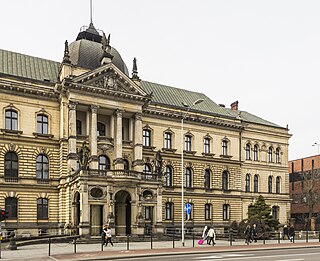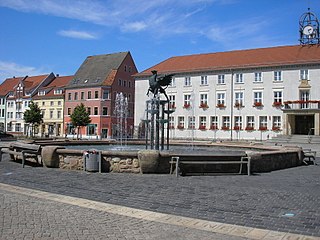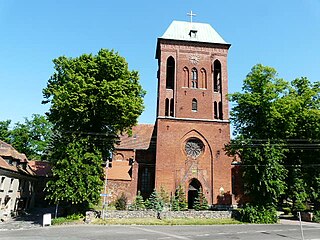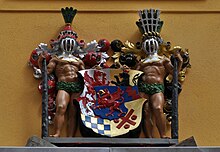
Pomerania is a historical region on the southern shore of the Baltic Sea in Central Europe, split between Poland and Germany. The central and eastern part belongs to the West Pomeranian, Pomeranian and Kuyavian-Pomeranian voivodeships of Poland, while the western part belongs to the German states of Mecklenburg-Western Pomerania and Brandenburg.

Szczecin is the capital and largest city of the West Pomeranian Voivodeship in northwestern Poland. Located near the Baltic Sea and the German border, it is a major seaport and Poland's seventh-largest city. As of 31 December 2022, the population was 391,566.

Stralsund, officially the Hanseatic City of Stralsund, is the fifth-largest city in the northeastern German federal state of Mecklenburg-Western Pomerania after Rostock, Schwerin, Neubrandenburg and Greifswald, and the second-largest city in the Pomeranian part of the state. It is located on the southern coast of the Strelasund, a sound of the Baltic Sea separating the island of Rügen from the Pomeranian mainland.

Anklam, formerly known as Tanglim and Wendenburg, is a town in the Western Pomerania region of Mecklenburg-Vorpommern in north-eastern Germany. It is situated on the banks of the Peene river, just 8 km from its mouth in the Kleines Haff, the western part of the Szczecin Lagoon. Anklam has a population of 12,177 (2021) and was the capital of the former Ostvorpommern district. Since September 2011, it has been part of the district of Vorpommern-Greifswald.

Swedish Pomerania was a dominion under the Swedish Crown from 1630 to 1815 on what is now the Baltic coast of Germany and Poland. Following the Polish War and the Thirty Years' War, Sweden held extensive control over the lands on the southern Baltic coast, including Pomerania and parts of Livonia and Prussia.

Pomerelia, also known as Eastern Pomerania, Vistula Pomerania, and also before World War II as Polish Pomerania, is a historical sub-region of Pomerania on the southern shore of the Baltic Sea in northern Poland.

The history of Pomerania starts shortly before 1000 AD, with ongoing conquests by newly arrived Polan rulers. Before that, the area was recorded nearly 2000 years ago as Germania, and in modern times Pomerania has been split between Germany and Poland. Its name comes from the Old Polish po more, which means "(land) at the sea".

Demmin is a town in the Mecklenburgische Seenplatte district, Mecklenburg-Western Pomerania, in north-eastern Germany. It was the capital of the former district of Demmin.

The Province of Pomerania was a province of Prussia from 1815 to 1945. Pomerania was established as a province of the Kingdom of Prussia in 1815, an expansion of the older Brandenburg-Prussia province of Pomerania, and then became part of the German Empire in 1871. From 1918, Pomerania was a province of the Free State of Prussia until it was dissolved following World War II by decree of the Allied Control Council with the de jure abolition of Prussia on 25 February 1947, and its territory divided between Poland and Allied-occupied Germany. The city of Stettin was the provincial capital.

The Bishopric of Cammin was both a former Roman Catholic diocese in the Duchy of Pomerania from 1140 to 1544, and a secular territory of the Holy Roman Empire (Prince-Bishopric) in the Kołobrzeg area from 1248 to 1650.

The Schlawe and Stolp Land, also known as Słupsk and Sławno Land, is a historical region in Pomerania, centered on the towns of Sławno (Schlawe) and Słupsk (Stolp) in Farther Pomerania, in present-day Poland.

Pomerania during the Early Middle Ages covers the History of Pomerania from the 7th to the 11th centuries.

Pomerania during the Early Modern Age covers the history of Pomerania in the 16th, 17th, and 18th centuries.

History of Pomerania (1806–1933) covers the history of Pomerania from the early 19th century until the rise of Nazi Germany.
Medieval Pomerania was converted from Slavic paganism to Christianity by Otto of Bamberg in 1124 and 1128, and in 1168 by Absalon.

The Duchy of Pomerania was partitioned several times to satisfy the claims of the male members of the ruling House of Pomerania dynasty. The partitions were named after the ducal residences: Pomerania-Barth, -Demmin, -Rügenwalde, -Stettin, -Stolp, and -Wolgast. None of the partitions had a hereditary character, the members of the House of Pomerania inherited the duchy in common. The duchy thus continued to exist as a whole despite its division. The only exception was made during a war with the Margraviate of Brandenburg, when in 1338 Barnim III of Pomerania-Stettin was granted his partition as a fief directly from the Holy Roman Emperor, while Pomerania-Wolgast remained under formal Brandenburgian overlordship. However, already in 1348, German king and later emperor Charles IV again granted the Duchy of Pomerania as a whole and the Principality of Rügen as a fief to the dukes of both Pomerania-Stettin and Pomerania-Wolgast, nullifying Brandenburg's claims by granting Imperial immediacy.
Duchy of Pomerania-Barth was a feudal duchy of the Holy Roman Empire located in Western Pomerania that existed in the Middle Ages between 1376 and 1478, and between 1569 and 1625. The state consisted of its capital, Barth, and nearby areas. Duchy had separated from Pomerania-Wolgast in 1376 and was incorporated into Duchy of Pomerania in 1478. It was reestablished in 1569 by separation from Pomerania-Wolgast-Stolp and existed until 1625, when it was incorporated into Duchy of Pomerania.

The Region of Stralsund belonged to the Prussian Province of Pomerania and existed from 1818 to 1932.

Historical Western Pomerania, also called Cispomerania,Fore Pomerania, Front Pomerania or Hither Pomerania, is the western extremity of the historic region of Pomerania forming the southern coast of the Baltic Sea, located mostly in north-eastern Germany, with a small portion in north-western Poland.

Old Western Pomerania or Old Hither Pomerania was the part of Western Pomerania that went to Prussia under the terms of the Treaty of Stockholm in 1720, now divided between Poland and Germany.















